8 surprisingly fun games Uncle Sam told soldiers to play in 1943
Occupy mind and body, manage stress, provide tactical training — oh, and slap buttocks
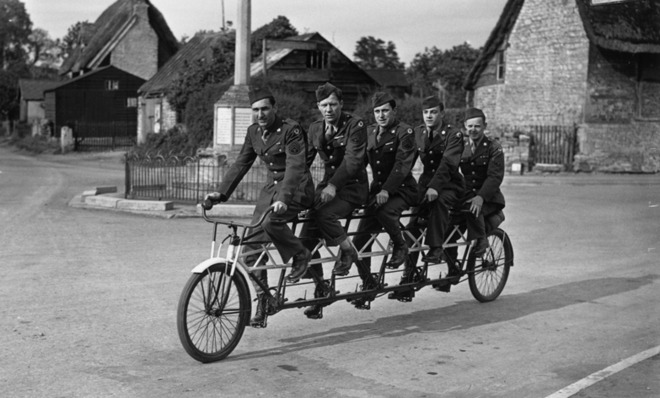

In 1943, the U.S. War Department issued a manual packed with "informal" games that men might play if they were lucky enough to have downtime. The games were intended to occupy mind and body, manage stress, and subtly provide tactical training. Which might explain why so many games involved tackling and beating your fellow soldiers. But other, less physical games translate great from the barracks to the backyard. Here are eight of our favorites:
1. One Out
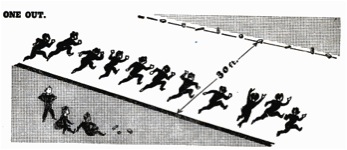
Equipment: Any easily obtained objects, such as sticks, shirts, or rocks
The Week
Escape your echo chamber. Get the facts behind the news, plus analysis from multiple perspectives.

Sign up for The Week's Free Newsletters
From our morning news briefing to a weekly Good News Newsletter, get the best of The Week delivered directly to your inbox.
From our morning news briefing to a weekly Good News Newsletter, get the best of The Week delivered directly to your inbox.
How to play: This is basically a game of musical chairs meant for soldiers instead of toddlers. So, no music, no graham crackers, but probably a comparable amount of shoving and punching. A line of sticks or similar objects are laid about 40 feet from the players. If there are 10 players, only 9 sticks are laid out, and so forth. At the signal, the players race to the line, "secure" themselves a stick, and race back. The player left stick-less is out, until only one remains.
2. Team Stick Guard
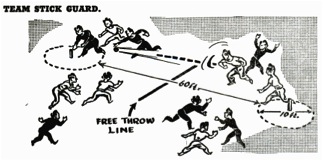
Equipment: A ball and two sticks
How to play: This game is a small serving of Capture the Flag with a heavy side of basketball. Each team has their own stick driven into the ground, surrounded by a 10-foot circle and a "goalie" to protect it. No other players are allowed in the goalie's circle. The referee begins play by throwing the ball between two men of opposing teams. The aim is for them to maneuver the ball close enough to knock the other team's stick out of the ground. Many of the rules from basketball apply: no running with the ball, holding, tripping, tackling, or touching. Such fouls results in a free throw at the opposing stick from the center of the field. The losing team is the one with the most knocked over pin.
A free daily email with the biggest news stories of the day – and the best features from TheWeek.com
3. Box Hockey
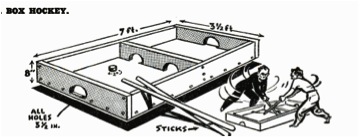
Equipment: A homemade box (7 feet by 3.5 feet, with or without a bottom) matching the one above, two sticks, and a ball or piece of wood small enough to fit through the holes
How to play: First, build the box, which probably took all of 20 minutes for men of this generation. From there, its air hockey with less finger pinching and more accidental knee clubbing. Start the game with the ball balanced on the center partition. Clap sticks three times above the ball, and the game is on. The goal is to get the ball through your opponent's hole. If the ball is knocked out of the arena, it is rolled back in on the opposite side. No stepping inside the box; first person to five points is the winner.
4. Rooster Fight
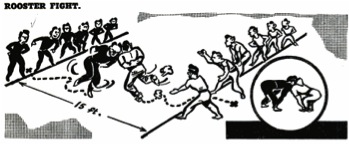
Equipment: None
How to play: A man from each team is called out, and he must hop on one foot, hands held behind his back, to meet his opponent. The winning man is the one who knocks the other over, or causes him to put his foot down or arms out for balance. Another posture for the game is called "The Drake," which is hands never leaving ankles, as shown in the circle above. (This game thinly avoids becoming bloody combat by wisely removing most dangerous appendages from the battle.)
5. Log Roll
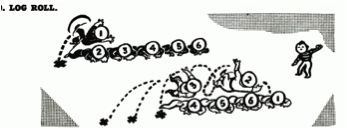
Equipment: Grassy area or floor mats
How to play: Two teams lie side by side on the ground. Starting with the end man, each player must roll over his entire team as soon as he himself is rolled over. The winner is the first team to have their front man roll over all of his men.
6. Chain Dodge Ball
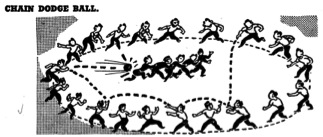
Equipment: Kickball or other soft ball
How to play: This version of dodge ball adds a complex but fun twist. The men form groups of four to six players, each player holding the waist of the person in front of him. Everyone else forms a circle around them. The object is to hit only the end man of the "It" team with the ball. Players in the circle can toss the ball anyway they think will accomplish this, and the "It" team can weave and run and flex in any formation possible to avoid it. The front man of the team can even use his hands to bat away the ball from the end man. The players are picked off one by one until the whole team is eliminated. Whichever team stayed inside the circle the longest is the winner.
7. Quick Line Up
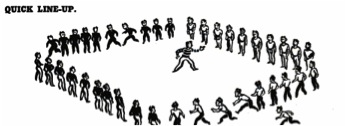
Equipment: None
How to play: Simon Says with a loyal army at his feet. The players divide into four equal teams and line up, tallest to shortest, forming a square around the man who's "It." The four lines are designated, "1, 2, 3, 4." Now "It" can walk anywhere he wants on the field, and wherever he stops, the other players must scramble to reassemble their lines around him, same position, same sides. One point to the team who assembles correctly the fastest, first team to five points win.
8. Baste the Bear
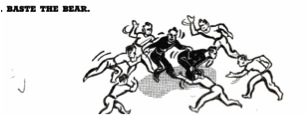
Equipment: Buttocks
How to play: As full as this manual was of beating games, full-on assault games, and uncomfortably intimate games, it seemed unprincipled not to include at least one. One of the "tamer" rough games is Baste the Bear. The "Bear" in this case must bend at the center of the circle, his posterior presented. He has a "Keeper" whose job it is to protect his rump. The rest of the players circle, trying to slap the bear's buttocks with their open hands. If the Keeper tags a slapper when they reach toward the Bear, the slapper is the new Bear and selects his own tush guardian. Under scoring and winners, the manual simply lists, "None."
Therese O'Neill lives in Oregon and writes for The Atlantic, Mental Floss, Jezebel, and more. She is the author of New York Times bestseller Unmentionable: The Victorian Ladies Guide to Sex, Marriage and Manners. Meet her at writerthereseoneill.com.
-
 Political cartoons for December 14
Political cartoons for December 14Cartoons Sunday's political cartoons include a new White House flag, Venezuela negotiations, and more
-
 Heavenly spectacle in the wilds of Canada
Heavenly spectacle in the wilds of CanadaThe Week Recommends ‘Mind-bending’ outpost for spotting animals – and the northern lights
-
 Facial recognition: a revolution in policing
Facial recognition: a revolution in policingTalking Point All 43 police forces in England and Wales are set to be granted access, with those against calling for increasing safeguards on the technology
